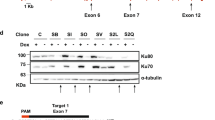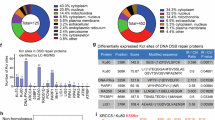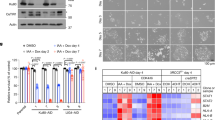Abstract
Ku70 forms a heterodimer with Ku80, called Ku that is well known for repairing DNA double-strand breaks through non-homologous end joining. As a result, deletion of either causes a very similar phenotype in mice that includes hypersensitivity to clastogens and early aging. In addition, deletion of Ku80 along with the cell cycle checkpoint protein, p53, dramatically increases the incidence of pro-B-cell lymphoma. Even though Ku70- p53-mutant mice have not been analysed, a logical assumption is they would exhibit the same cancer phenotype. Here, we test this assumption by comparing p53-mutant littermates deleted for either Ku70 or Ku80 or both. We find this assumption to be incorrect as p53-mutants live significantly longer when deleted for Ku70 rather than Ku80 or Ku70+Ku80. We also find the former cohort displays much lower levels of pro-B-cell lymphoma than the latter two cohorts. As pro-B-cell lymphoma is caused by a translocation between chromosomes 12 and 15, we tested fibroblasts for DNA repair capacity, and found that p53-mutant fibroblasts are more sensitive to streptonigrin and paraquat when deleted for Ku80 as compared with Ku70. Thus, Ku80 may function outside the Ku heterodimer to influence DNA damage repair presenting the possibility that Ku80 influenced the open coding ends in a manner that suppressed a cancer-causing translocation.
This is a preview of subscription content, access via your institution
Access options
Subscribe to this journal
Receive 50 print issues and online access
$259.00 per year
only $5.18 per issue
Buy this article
- Purchase on SpringerLink
- Instant access to full article PDF
Prices may be subject to local taxes which are calculated during checkout


Similar content being viewed by others
References
Bolzan AD, Bianchi MS . (2001). Genotoxicity of streptonigrin: a review. Mutat Res 488: 25–37.
Brown KD, Lataxes TA, Shangary S, Mannino JL, Giardina JF, Chen J et al. (2000). Ionizing radiation exposure results in up-regulation of Ku70 via a p53/ataxia-telangiectasia-mutated protein-dependent mechanism. J Biol Chem 275: 6651–6656.
Burma S, Chen BP, Chen DJ . (2006). Role of non-homologous end joining (NHEJ) in maintaining genomic integrity. DNA Repair (Amst) 5: 1042–1048.
Bus JS, Aust SD, Gibson JE . (1974). Superoxide- and singlet oxygen-catalyzed lipid peroxidation as a possible mechanism for paraquat (methyl viologen) toxicity. Biochem Biophys Res Commun 58: 749–755.
Difilippantonio MJ, Zhu J, Chen HT, Meffre E, Nussenzweig MC, Max EE et al. (2000). DNA repair protein Ku80 suppresses chromosomal aberrations and malignant transformation. Nature 404: 510–514.
Donehower LA, Harvey M, Slagle BL, McArthur MJ, Montgomery Jr CA, Butel JS et al. (1992). Mice deficient for p53 are developmentally normal but susceptible to spontaneous tumours. Nature 356: 215–221.
Gao Y, Ferguson DO, Xie W, Manis JP, Sekiguchi J, Frank KM et al. (2000). Interplay of p53 and DNA-repair protein XRCC4 in tumorigenesis, genomic stability and development. Nature 404: 897–900.
Goedecke W, Eijpe M, Offenberg HH, van Aalderen M, Heyting C . (1999). Mre11 and Ku70 interact in somatic cells, but are differentially expressed in early meiosis. Nat Genet 23: 194–198.
Gomez JA, Gama V, Yoshida T, Sun W, Hayes P, Leskov K et al. (2007). Bax-inhibiting peptides derived from Ku70 and cell-penetrating pentapeptides. Biochem Soc Trans 35: 797–801.
Gu Y, Jin S, Gao Y, Weaver DT, Alt FW . (1997a). Ku70-deficient embryonic stem cells have increased ionizing radiosensitivity, defective DNA end-binding activity, and inability to support V(D)J recombination. Proc Natl Acad Sci USA 94: 8076–8081.
Gu Y, Seidl KJ, Rathbun GA, Zhu C, Manis JP, van der Stoep N et al. (1997b). Growth retardation and leaky SCID phenotype of Ku70-deficient mice. Immunity 7: 653–665.
Gu Y, Sekiguchi J, Gao Y, Dikkes P, Frank K, Ferguson D et al. (2000). Defective embryonic neurogenesis in Ku-deficient but not DNA-dependent protein kinase catalytic subunit-deficient mice. Proc Natl Acad Sci USA 97: 2668–2673.
Holcomb VB, Rodier F, Choi Y, Busuttil RA, Vogel H, Vijg J et al. (2008). Ku80 deletion suppresses spontaneous tumors and induces a p53-mediated DNA damage response. Cancer Res 68: 9497–9502.
Holcomb VB, Vogel H, Hasty P . (2007). Deletion of Ku80 causes early aging independent of chronic inflammation and Rag-1-induced DSBs. Mech Ageing Dev 128: 601–608.
Holcomb VB, Vogel H, Marple T, Kornegay RW, Hasty P . (2006). Ku80 and p53 suppress medulloblastoma that arise independent of Rag-1-induced DSBs. Oncogene 25: 7159–7165.
Hsu HL, Gilley D, Galande SA, Hande MP, Allen B, Kim SH et al. (2000). Ku acts in a unique way at the mammalian telomere to prevent end joining. Genes Dev 14: 2807–2812.
Koike M, Shiomi T, Koike A . (2000). Ku70 can translocate to the nucleus independent of Ku80 translocation and DNA-PK autophosphorylation. Biochem Biophys Res Commun 276: 1105–1111.
Li H, Vogel H, Holcomb VB, Gu Y, Hasty P . (2007). Deletion of Ku70, Ku80, or both causes early aging without substantially increased cancer. Mol Cell Biol 27: 8205–8214.
Lim DS, Vogel H, Willerford DM, Sands AT, Platt KA, Hasty P . (2000). Analysis of ku80-mutant mice and cells with deficient levels of p53. Mol Cell Biol 20: 3772–3780.
Lim JW, Kim KH, Kim H . (2008). NF-kappaB p65 regulates nuclear translocation of Ku70 via degradation of heat shock cognate protein 70 in pancreatic acinar AR42J cells. Int J Biochem Cell Biol 40: 2065–2077.
Marple T, Li H, Hasty P . (2004). A genotoxic screen: rapid analysis of cellular dose-response to a wide range of agents that either damage DNA or alter genome maintenance pathways. Mutat Res 554: 253–266.
Mazumder S, Plesca D, Kinter M, Almasan A . (2007). Interaction of a cyclin E fragment with Ku70 regulates Bax-mediated apoptosis. Mol Cell Biol 27: 3511–3520.
Munakata Y, Saito-Ito T, Kumura-Ishii K, Huang J, Kodera T, Ishii T et al. (2005). Ku80 autoantigen as a cellular coreceptor for human parvovirus B19 infection. Blood 106: 3449–3456.
Nussenzweig A, Chen C, da Costa Soares V, Sanchez M, Sokol K, Nussenzweig MC et al. (1996). Requirement for Ku80 in growth and immunoglobulin V(D)J recombination. Nature 382: 551–555.
Riley T, Sontag E, Chen P, Levine A . (2008). Transcriptional control of human p53-regulated genes. Nat Rev Mol Cell Biol 9: 402–412.
Romero F, Dargemont C, Pozo F, Reeves WH, Camonis J, Gisselbrecht S et al. (1996). p95vav associates with the nuclear protein Ku-70. Mol Cell Biol 16: 37–44.
Song K, Jung D, Jung Y, Lee SG, Lee I . (2000). Interaction of human Ku70 with TRF2. FEBS Lett 481: 81–85.
Song K, Jung Y, Jung D, Lee I . (2001). Human Ku70 interacts with heterochromatin protein 1alpha. J Biol Chem 276: 8321–8327.
Vogel H, Lim DS, Karsenty G, Finegold M, Hasty P . (1999). Deletion of Ku86 causes early onset of senescence in mice. Proc Natl Acad Sci USA 96: 10770–10775.
Wang J, Dong X, Myung K, Hendrickson EA, Reeves WH . (1998). Identification of two domains of the p70 Ku protein mediating dimerization with p80 and DNA binding. J Biol Chem 273: 842–848.
Yang CR, Yeh S, Leskov K, Odegaard E, Hsu HL, Chang C et al. (1999). Isolation of Ku70-binding proteins (KUBs). Nucleic Acids Res 27: 2165–2174.
Zhu C, Bogue MA, Lim DS, Hasty P, Roth DB . (1996). Ku86-deficient mice exhibit severe combined immunodeficiency and defective processing of V(D)J recombination intermediates. Cell 86: 379–389.
Zhu P, Zhang D, Chowdhury D, Martinvalet D, Keefe D, Shi L et al. (2006). Granzyme A, which causes single-stranded DNA damage, targets the double-strand break repair protein Ku70. EMBO Rep 7: 431–437.
Acknowledgements
This work was supported by the following grants from the NIH: R01 CA76317-05A1, 3P30 CA054174-16S2, P01 AG17242 and UO1 ES11044 to PH.
Author information
Authors and Affiliations
Corresponding author
Rights and permissions
About this article
Cite this article
Li, H., Choi, Y., Hanes, M. et al. Deleting Ku70 is milder than deleting Ku80 in p53-mutant mice and cells. Oncogene 28, 1875–1878 (2009). https://doi.org/10.1038/onc.2009.57
Received:
Revised:
Accepted:
Published:
Issue date:
DOI: https://doi.org/10.1038/onc.2009.57
Keywords
This article is cited by
-
Characterization of HIV-1 integrase interaction with human Ku70 protein and initial implications for drug targeting
Scientific Reports (2017)
-
Bax deficiency extends the survival of Ku70 knockout mice that develop lung and heart diseases
Cell Death & Disease (2015)
-
Ku is a 5′-dRP/AP lyase that excises nucleotide damage near broken ends
Nature (2010)



